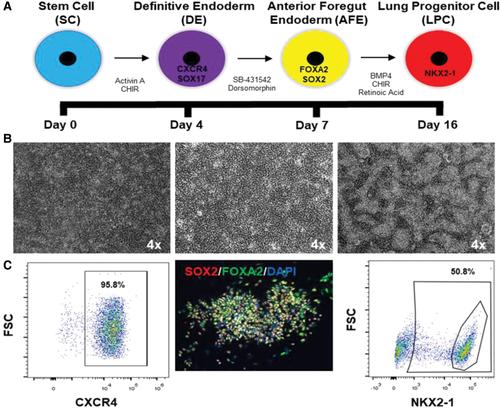下载PDF
{"title":"Generation of Complete Multi−Cell Type Lung Organoids From Human Embryonic and Patient-Specific Induced Pluripotent Stem Cells for Infectious Disease Modeling and Therapeutics Validation","authors":"Sandra L. Leibel, Rachael N. McVicar, Alicia M. Winquist, Walter D. Niles, Evan Y. Snyder","doi":"10.1002/cpsc.118","DOIUrl":null,"url":null,"abstract":"<p>The normal development of the pulmonary system is critical to transitioning from placental-dependent fetal life to alveolar-dependent newborn life. Human lung development and disease have been difficult to study due to the lack of an in vitro model system containing cells from the large airways and distal alveolus. This article describes a system that allows human embryonic stem cells (hESCs) and induced pluripotent stem cells (hiPSCs) to differentiate and form three-dimensional (3D) structures that emulate the development, cytoarchitecture, and function of the lung (“organoids”), containing epithelial and mesenchymal cell populations, and including the production of surfactant and presence of ciliated cells. The organoids can also be invested with mesoderm derivatives, differentiated from the same human pluripotent stem cells, such as alveolar macrophages and vasculature. Such lung organoids may be used to study the impact of environmental modifiers and perturbagens (toxins, microbial or viral pathogens, alterations in microbiome) or the efficacy and safety of drugs, biologics, and gene transfer. © 2020 Wiley Periodicals LLC.</p><p><b>Basic Protocol</b>: hESC/hiPSC dissection, definitive endoderm formation, and lung progenitor cell induction</p>","PeriodicalId":53703,"journal":{"name":"Current Protocols in Stem Cell Biology","volume":"54 1","pages":""},"PeriodicalIF":0.0000,"publicationDate":"2020-07-08","publicationTypes":"Journal Article","fieldsOfStudy":null,"isOpenAccess":false,"openAccessPdf":"https://sci-hub-pdf.com/10.1002/cpsc.118","citationCount":"33","resultStr":null,"platform":"Semanticscholar","paperid":null,"PeriodicalName":"Current Protocols in Stem Cell Biology","FirstCategoryId":"1085","ListUrlMain":"https://onlinelibrary.wiley.com/doi/10.1002/cpsc.118","RegionNum":0,"RegionCategory":null,"ArticlePicture":[],"TitleCN":null,"AbstractTextCN":null,"PMCID":null,"EPubDate":"","PubModel":"","JCR":"Q2","JCRName":"Biochemistry, Genetics and Molecular Biology","Score":null,"Total":0}
引用次数: 33
引用
批量引用
Abstract
The normal development of the pulmonary system is critical to transitioning from placental-dependent fetal life to alveolar-dependent newborn life. Human lung development and disease have been difficult to study due to the lack of an in vitro model system containing cells from the large airways and distal alveolus. This article describes a system that allows human embryonic stem cells (hESCs) and induced pluripotent stem cells (hiPSCs) to differentiate and form three-dimensional (3D) structures that emulate the development, cytoarchitecture, and function of the lung (“organoids”), containing epithelial and mesenchymal cell populations, and including the production of surfactant and presence of ciliated cells. The organoids can also be invested with mesoderm derivatives, differentiated from the same human pluripotent stem cells, such as alveolar macrophages and vasculature. Such lung organoids may be used to study the impact of environmental modifiers and perturbagens (toxins, microbial or viral pathogens, alterations in microbiome) or the efficacy and safety of drugs, biologics, and gene transfer. © 2020 Wiley Periodicals LLC.
Basic Protocol : hESC/hiPSC dissection, definitive endoderm formation, and lung progenitor cell induction
从人胚胎和患者特异性诱导多能干细胞中生成完整的多细胞型肺类器官用于传染病建模和治疗验证
肺系统的正常发育是由胎盘依赖的胎儿生命向肺泡依赖的新生儿生命过渡的关键。由于缺乏含有大气道和远端肺泡细胞的体外模型系统,人类肺的发育和疾病一直难以研究。本文描述了一个系统,允许人类胚胎干细胞(hESCs)和诱导多能干细胞(hiPSCs)分化并形成三维(3D)结构,模拟肺(“类器官”)的发育、细胞结构和功能,包含上皮和间充质细胞群,包括表面活性剂的产生和纤毛细胞的存在。类器官也可以注入中胚层衍生物,从相同的人类多能干细胞分化出来,如肺泡巨噬细胞和脉管细胞。这些肺类器官可用于研究环境调节剂和扰动原(毒素、微生物或病毒病原体、微生物组的改变)的影响,或药物、生物制剂和基因转移的有效性和安全性。基本方案:hESC/hiPSC解剖,最终内胚层形成,肺祖细胞诱导
本文章由计算机程序翻译,如有差异,请以英文原文为准。



